This vegan pie crust is flavourful, flaky, and easier to make than you might think. It's perfect for making sweet and savoury pies. I've used it to make pumpkin pie, peach galette, tofu pot pies, and tofu quiche.
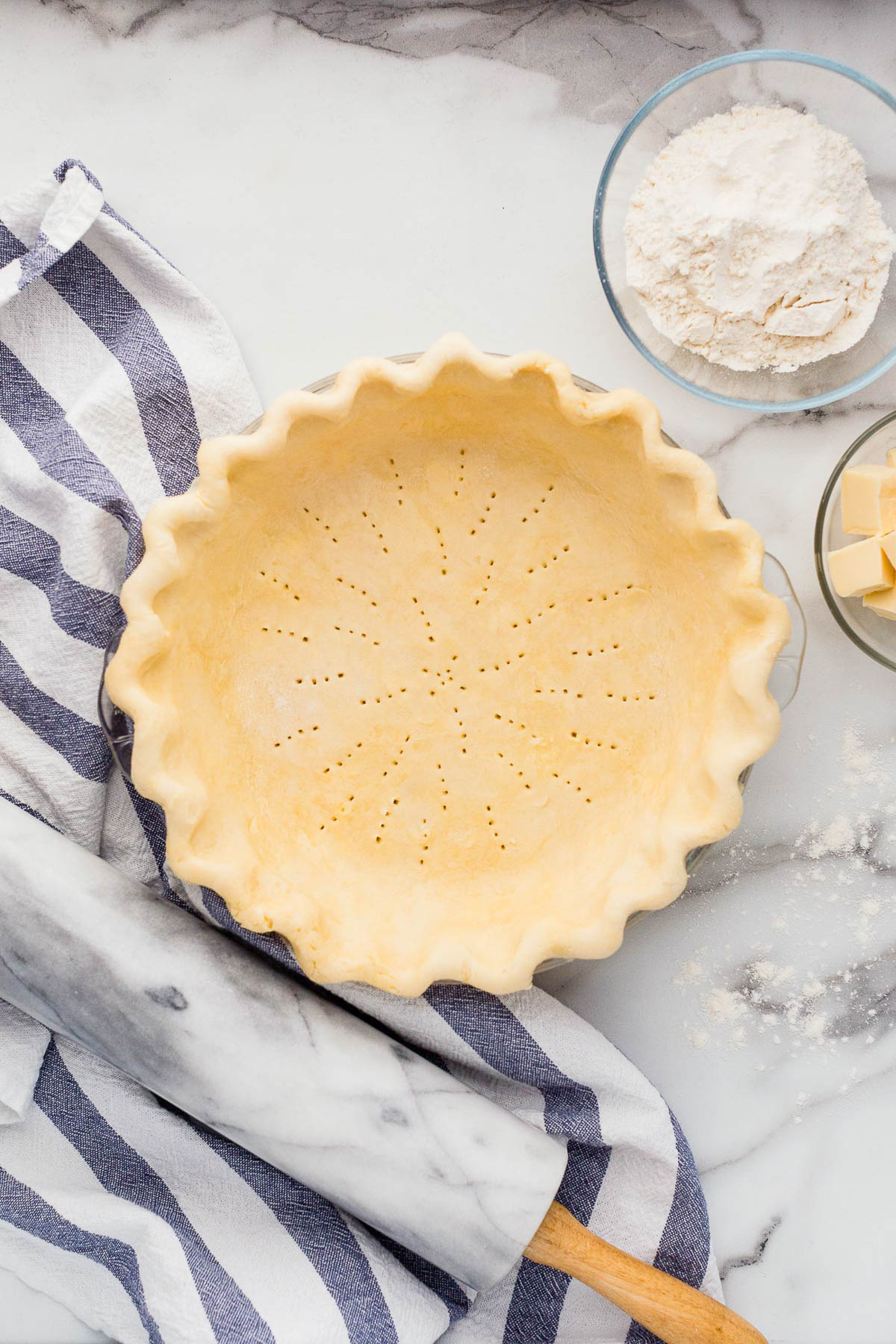
Making pie crust, vegan or not, can be a little daunting. But pie dough is more forgiving than you think! If your pie dough is cracking while you roll it out or it sticks to your counter when you try to transfer it to your pie plate, stay calm! A little patience goes a long way. Pie crust folklore suggests that the best pie crusts are always difficult to roll out. True or not, it’s a comforting notion if you’re struggling with a crumbling pie dough.
Something that makes pie crust seem challenging is that you’re relying on look and feel throughout the process. How small or large you cut the butter into the flour will change the amount of water you need to add. I've included pictures to help you gauge how fine to cut the butter and how much liquid is just right.
In this post, I included my best vegan pie crust tips, pros and cons of different fats, and step-by-step photos to walk you through the process.

Essentials for Making Vegan Pie Crust:
- Digital scale
- Mixing bowl
- Pastry blender (or a fork)
- Fork
- Plastic wrap
- Rolling pin
- Off-set metal spatula
- Pie plate
What makes pie crust flaky?
Pie dough is made up of both pockets of fat coated in flour and hydrated flour (water + flour). By cutting tiny pieces of fat into the dough and then rolling it out, you create super thin layers of fat and hydrated flour. While you bake the crust, the fat melts, the dough gets crisp, and those flaky separated layers become obvious. This is why it’s important to keep everything cold, it keeps the fat in a solid state so it can create those flaky layers when baked.
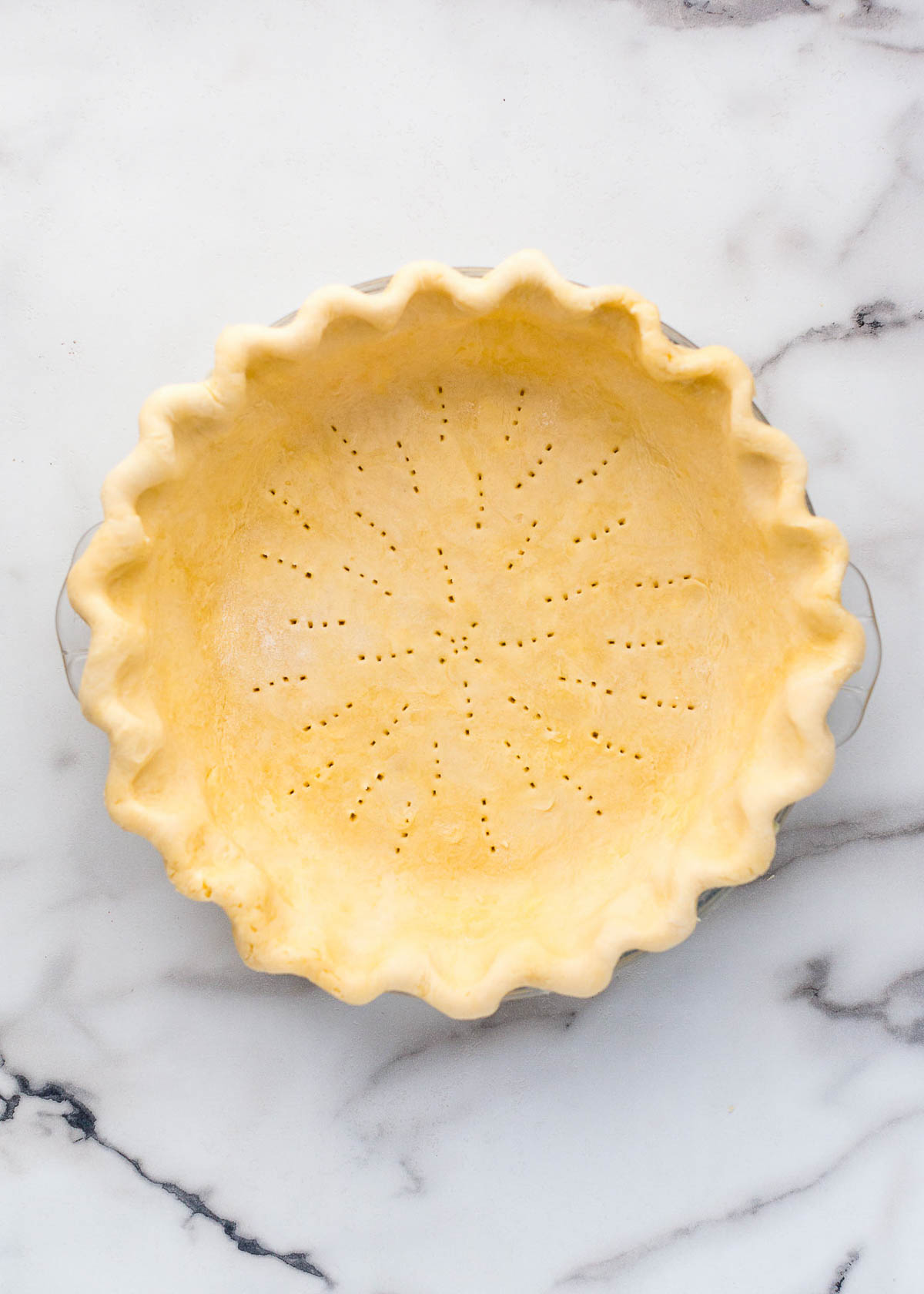
Best Vegan Pie Crust Tips:
- Measure flour and vegan butter by weight. A cheap, digital kitchen scale is one of the best tools your can have in your kitchen. It ensures consistent results just as the recipe developer intended. Why does it matter so much? The density of 1 cup of flour can vary greatly from person to person. One person's 1 cup can weigh as little as 120 grams, while another's can weigh as much as 180 grams. In a recipe calling for 2 cups of flour, a "dense measurer" could be using 1 whole extra cup of flour to the recipe! If that's not enough, measuring by weight is faster, easier, and uses fewer dishes.
- All ingredients and equipment should be as cold as possible. Place your measured butter and flour (plus extra for rolling), mixing bowl, pastry blender, fork, rolling pin, and spatula, in the freezer before getting started. If you have a large marble cutting board that you can roll your dough out on, chill that too!
- Add the (ice cold) water, 1 tablespoon at a time, and use as little as possible. Too much moisture = too much steam = a tough pie crust. (Adding too little water will make your pie dough harder to work with and prone to cracking. With a little patience your crust will still turn out flaky and tender.)
- Tightly wrap and chill your pie dough for at least 2 hours before rolling it out. This chills the dough and hydrates the flour making it easier to work with.
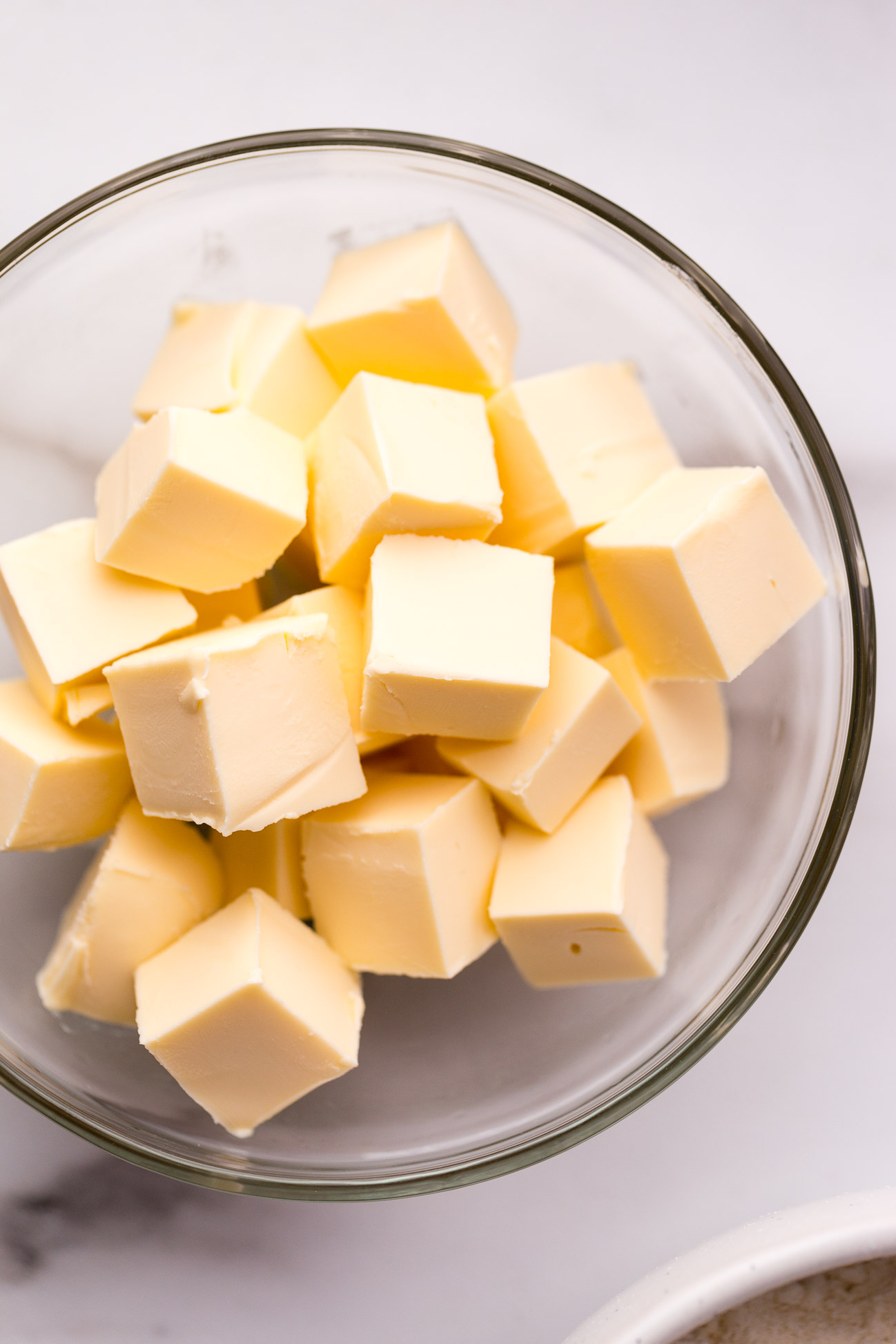
Vegan Butter vs. Vegetable Shortening vs. Coconut Oil
Vegan butter, vegetable shortening, and coconut oil are all solid fats which is exactly what you need for making vegan pie crust. But there are pros and cons to each.
Vegan Butter (Recommended for best flavour)
Choose a “vegan butter” that’s solid and hard to spread when cold. I always use Earth Balance for vegan pie crust. Do not use vegan margarine (like Becel Vegan) or any other products that are easy to spread straight from the refrigerator.
- Flavourful (classic butter taste)
- Easy to work with, roll out, etc.
- Not a pure fat. Depending on the brand you use, they’ll have varying moisture levels. (Use Earth Balance for best results.)
- More expensive than shortening
Vegetable shortening (Affordable and easy to work with)
- Bland flavour
- Very easy to work with, roll out, etc.
- Pure fat - no need to worry about varying moisture levels
- Less expensive than vegan butter
Coconut oil (Most difficult to work with)
- Coconut flavour (regular coconut oil) or bland flavour (refined coconut oil)
- Difficult to work with
- Requires strict temperature control. Coconut oil quickly moves between a solid and liquid state with minor temperature fluctuations.
- More time consuming (requires time to chill and warm while working).
- Pure fat - no need to work about varying moisture levels
- Price varies depending on brand
How to Make Vegan Pie Crust
Before you get started, chill all ingredients and tools.
1. Mix the flour and salt in a medium mixing bowl.
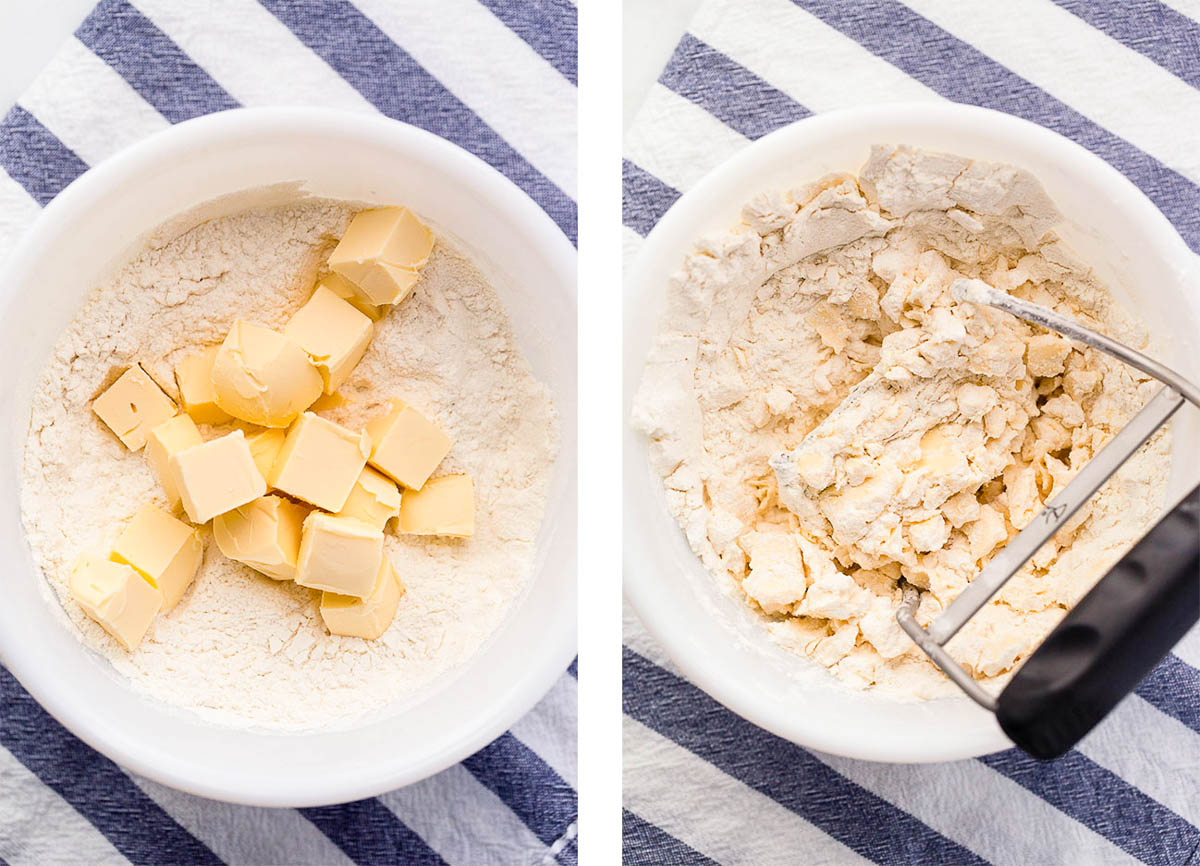
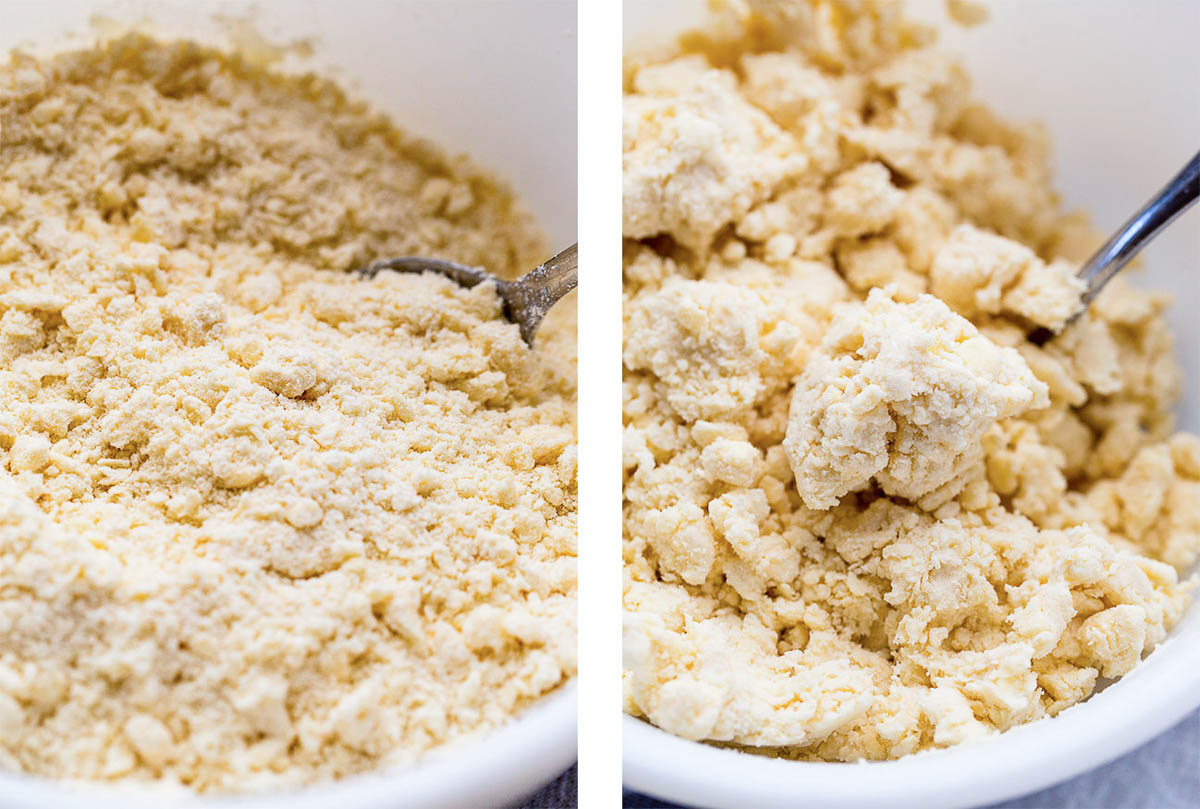
2. Cut the chilled vegan butter into the flour using a pastry blender or fork until the fat is in small pieces. The image above (left) shows the ideal texture.
Note: If you don’t cut the butter small enough, you’ll need to add more water to make the dough workable. Too much water = a tougher crust. If the butter is cut too small, the crust won't be as flaky.
3. Slowly add ice water, 1 tablespoon at a time, while gently mixing with a fork. Keep adding the water and stirring until the vegan pie dough starts to clump together on it’s own. The image above (right) shows how the dough should look, crumbly, but starting to hold together. The dough shouldn’t be wet or sticky.
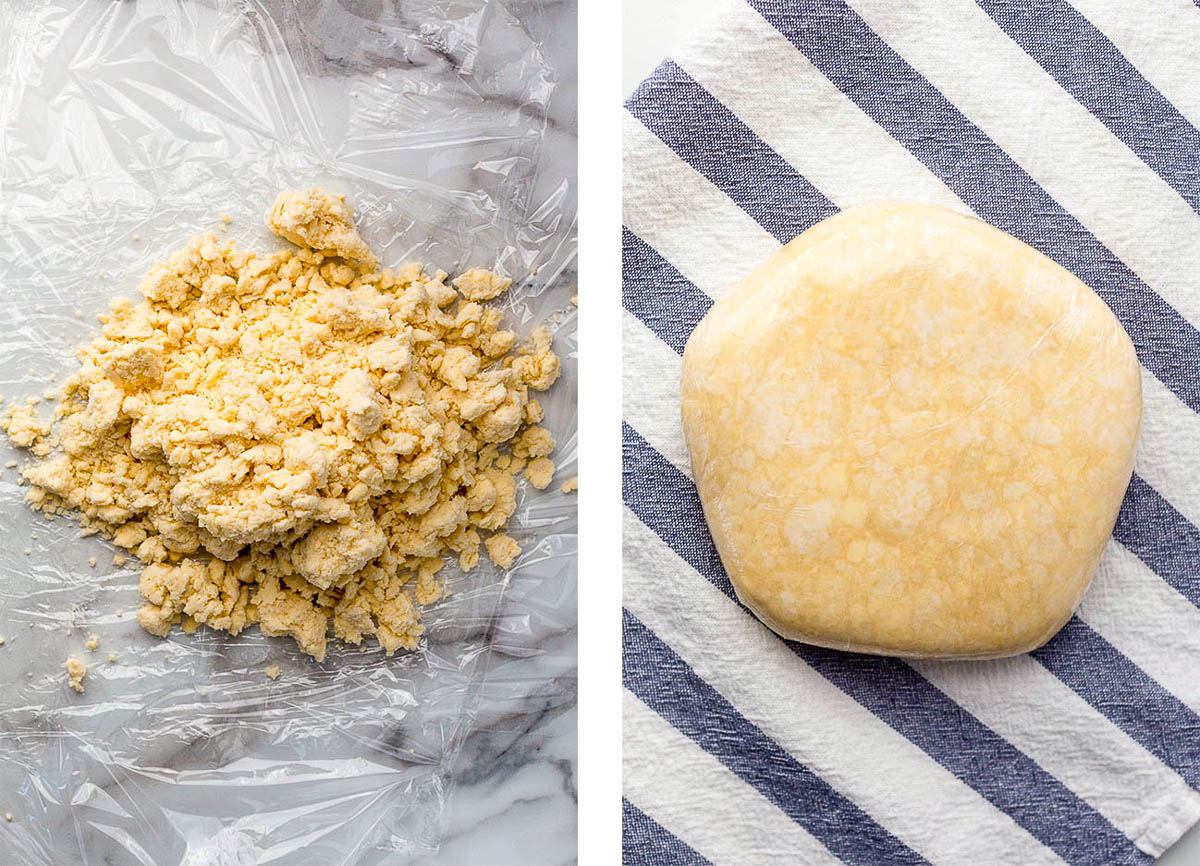
4. On your countertop, lay out a piece of plastic wrap (I use 2, laid out in a cross shape.) Dump the crumbly vegan pie dough in the center of the plastic wrap. Very tightly wrap the dough into a flat disk so that the dough doesn’t appear crumbly at all. Refrigerate for 2 hours before rolling out.
Tip: After wrapping the dough into a disk, squish it down, applying enough pressure to make the dough expand within the plastic wrap. This will make the dough compact and will help prevent cracked edges when you roll out the dough.
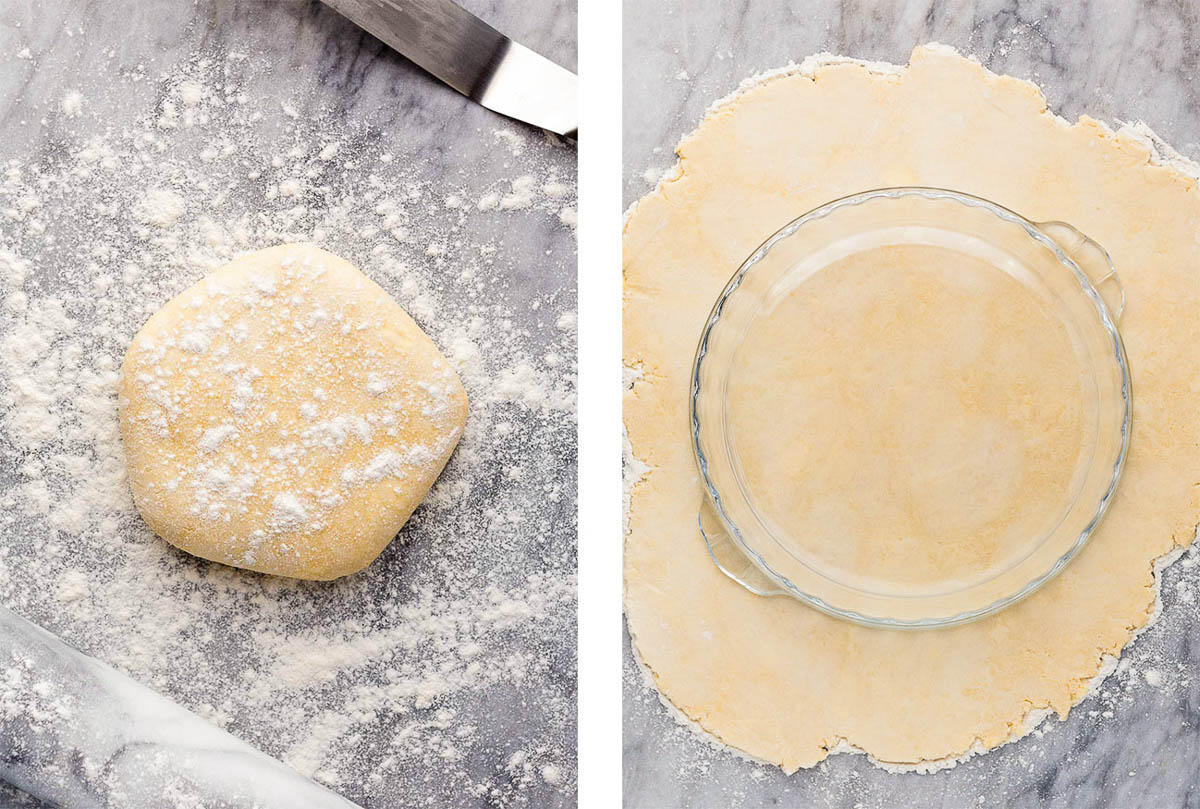
5. After chilling the dough, unwrap it and place it on a liberally floured surface. Start rolling from the center of the dough, out to the edges. Roll out the pie dough in different directions to achieve a roughly circular shape.
Tip: After every few passes with your rolling pin, use your metal spatula to release the dough from your work surface. Add more flour as needed.
Tip: If you’re concerned about the pie dough sticking, roll it out on a floured piece of parchment paper!
6. Roll out the dough until the dough is at least 2 inches larger than your pie plate. Gently lift the pie dough from your work surface using your metal spatula, and transfer it to your pie plate.
Tip: You can roll the dough onto your rolling pin to help transfer the dough to your pie plate.
Tip: If you have a ton of excess pie dough, you can cut away some of the excess to make it easier to transfer to your pie plate.
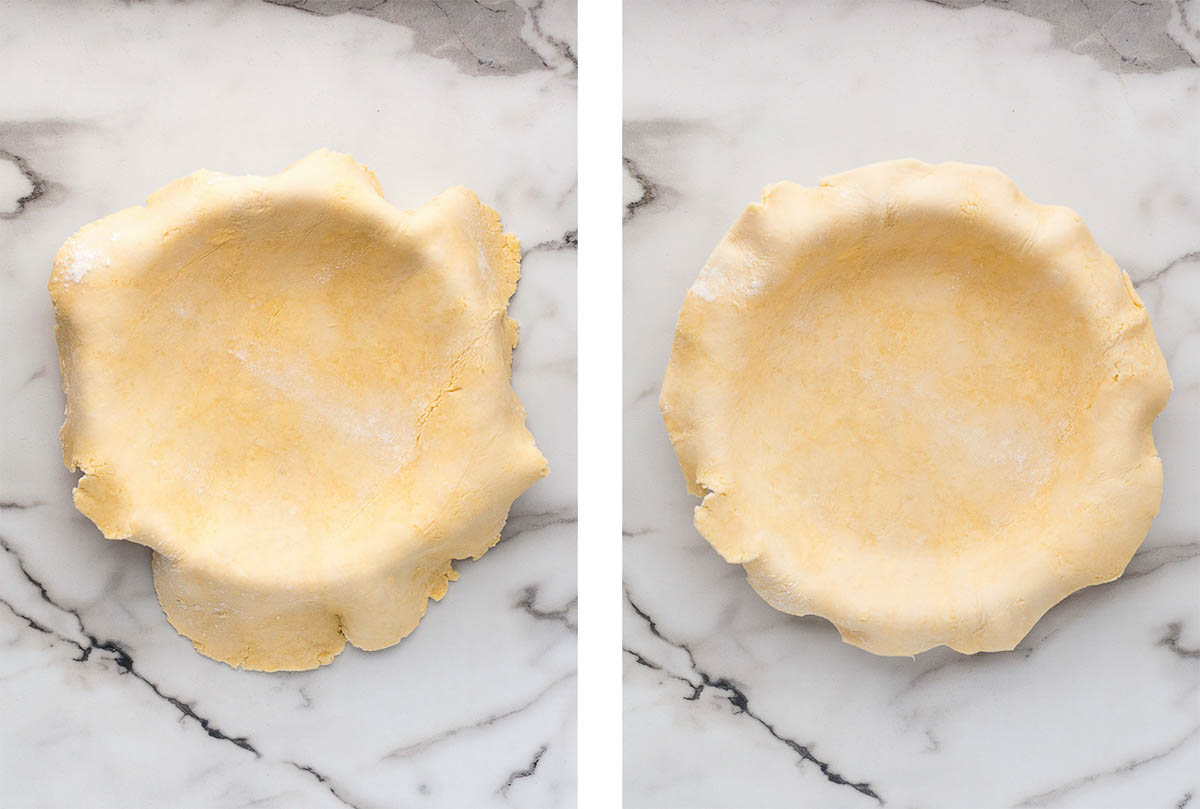
7. Making sure the dough lays flush with your pie plate, all the way into the corners. Leave 1 inch (2.5 cm) of excess for folding and fluting the edges, and cut away the rest.
8. Use your fingers to gently mend any cracks by lightly pinching and massaging them to smooth them out.
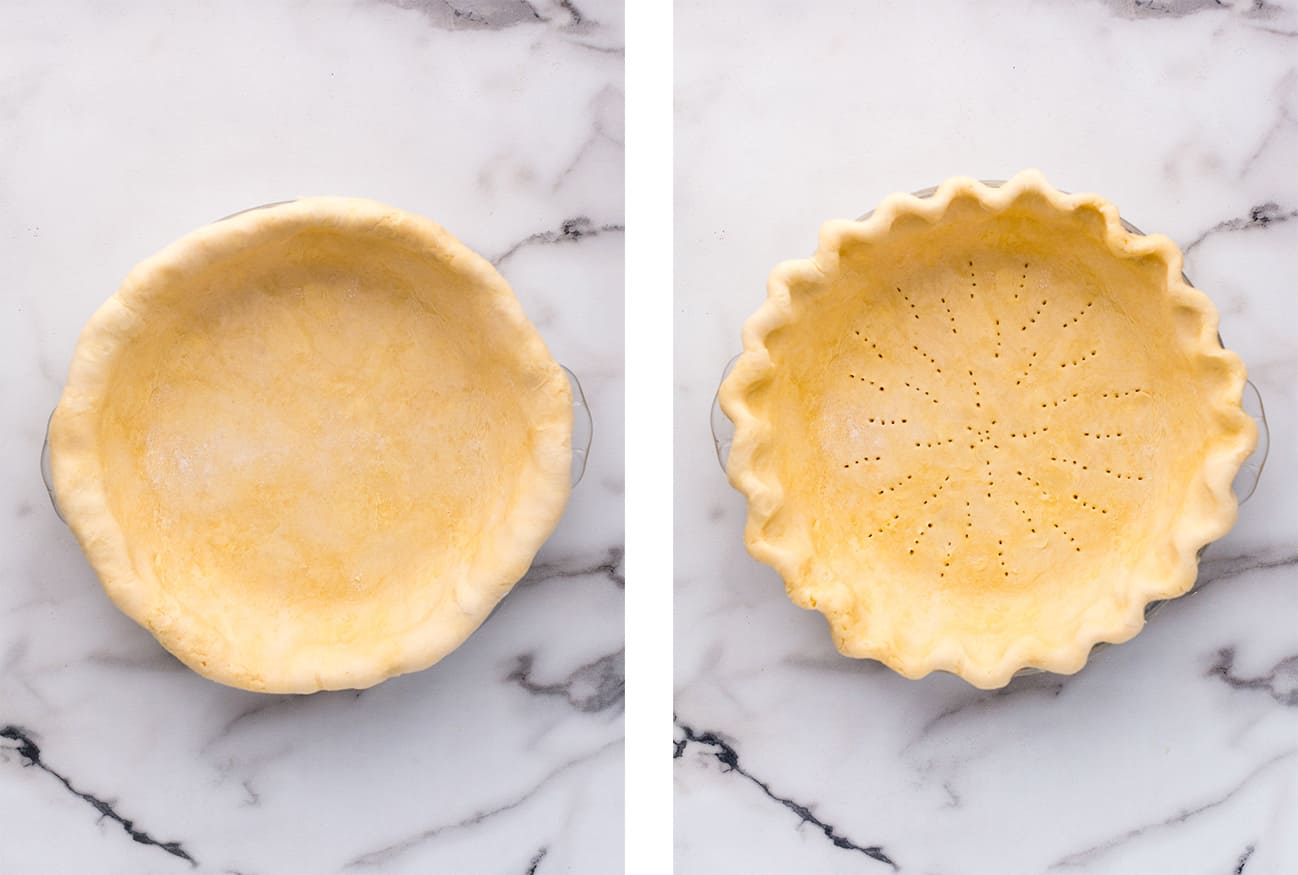
9. Slowly and gently fold the excess dough under itself to make a smooth, clean edge, folded on the lip of your pie plate.
10. Use the thumb and index finger of your dominant hand and the thumb of your non-dominant hand to pinch/flute the edge of your pie crust. Use a fork to pierce holes in the bottom of the crust.
Tip: For an easier alternative to fluting the edges, use a fork to press into the edges for a decorative effect.
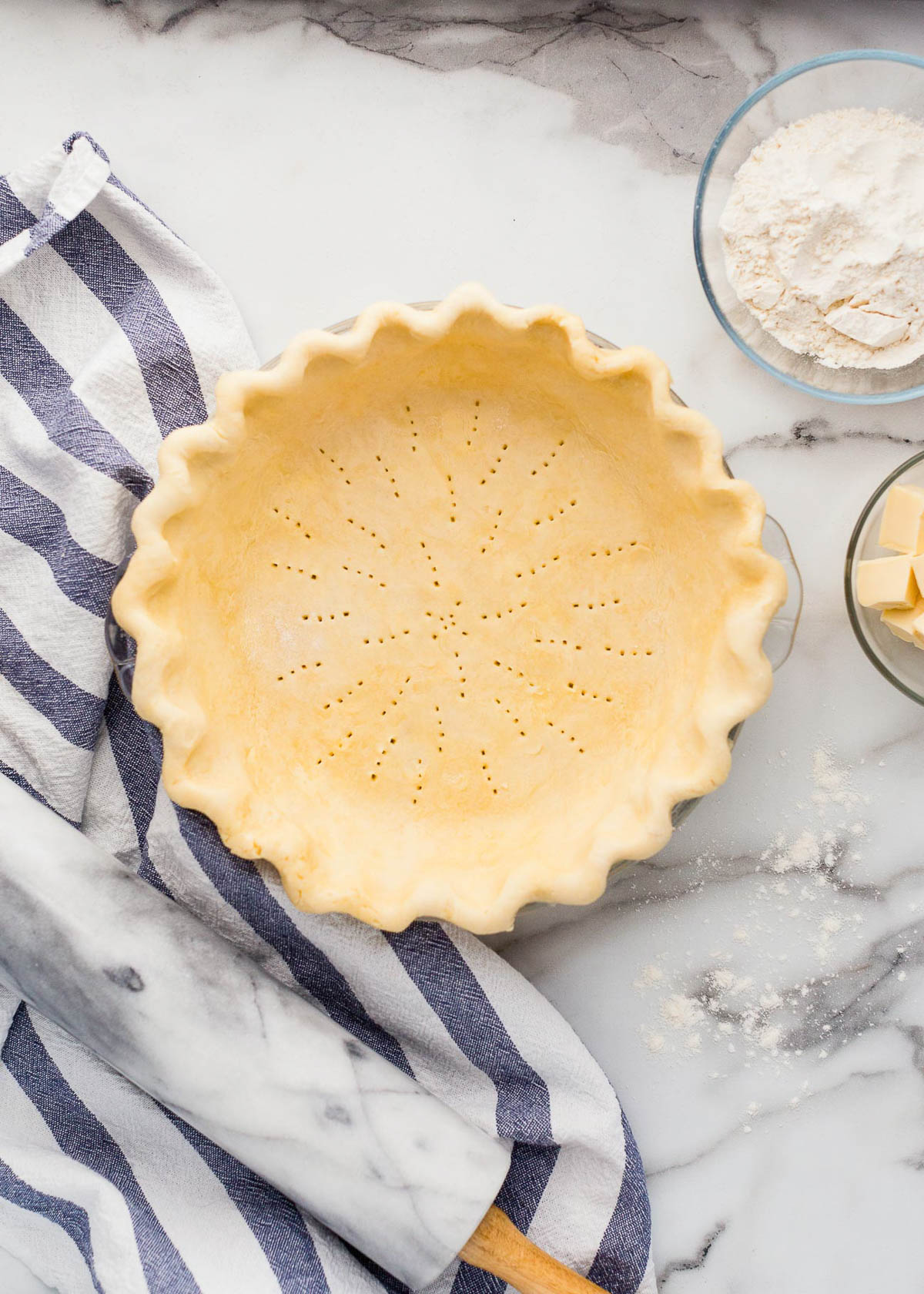
11. Chill or freeze your pie crust until ready to use.
In most cases you do not need to pre-bake or “blind bake” your crust. Only pre-bake the crust if the recipe calls for it.
Print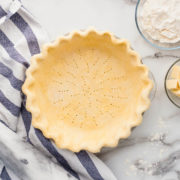
Flaky Vegan Pie Crust
- Prep Time: 2 hours 30 minutes
- Total Time: 2 hours 30 minutes
- Yield: 1 pie crust 1x
- Category: Pastry, Baking
- Method: Pastry
- Cuisine: Vegan
Description
This vegan pie crust is flavourful, flaky, and made with vegan butter. It's perfect for making sweet and savoury pies.
Ingredients
- 2 cups (240 grams) all-purpose flour
- ¼ tsp (1.25 ml) salt
- ¾ cup (170 grams) vegan butter (Earth Balance Buttery Spread)
- 4-8 tablespoon (60-120 ml) ice water
Instructions
Before you get started, chill all ingredients and tools.
- Mix the flour and salt in a medium mixing bowl.
- Cut the chilled vegan butter into the flour using a pastry blender or fork until the fat is in small pieces.
- Slowly add ice water, 1 tablespoon at a time, while gently mixing with a fork. Keep adding the water and stirring until the vegan pie dough starts to clump together on it’s own. The dough should look crumbly, but hold together. The dough shouldn’t be wet or sticky.
- On your countertop, lay out a piece of plastic wrap (I use 2, laid out in a cross shape.) Dump the crumbly vegan pie dough in the center of the plastic wrap. Very tightly wrap the dough into a flat disk so that the dough doesn’t appear crumbly at all. Refrigerate for 2 hours before rolling out.
- After chilling the dough, unwrap it and place it on a liberally floured surface. Start rolling from the center of the dough, out to the edges. Roll out the pie dough in different directions to achieve a roughly circular shape.
- Roll out the dough until the dough is at least 2 inches larger than your pie plate. Gently lift the pie dough from your work surface using your metal spatula, and transfer it to your pie plate.
- Making sure the dough lays flush with your pie plate, all the way into the corners. Leave 1 inch (2.5 cm) of excess for folding and fluting the edges, and cut away the rest.
- Use your fingers to gently mend any cracks by lightly pinching and massaging them to smooth them out.
- Slowly and gently fold the excess dough under itself to make a smooth, clean edge, folded on the lip of your pie plate.
- Use the thumb and index finger of your dominant hand and the thumb of your non-dominant hand to pinch/flute the edge of your pie crust. Use a fork to pierce holes in the bottom of the crust.
- Chill or freeze your pie crust until ready to use.
Notes
Refer to blog post for additional recipe notes and tips.
Keywords: vegan pie crust, vegan pie dough

Julee
Nope, I did something wrong, came out of the refrigerator, almost hard as a rock. Too much water or not enough maybe?
Ted Baumgart
Has anyone used Miyoko's European Style Cultured Vegan Butter for making pie crusts? To everyone's taste in my world this is by far the best tasting vegan butter whether friends are vegan or not (our whole family is vegan). It also has the qualities needed you have mentioned. Having never made a pie crust I will give it a go with Miyoko.
Sue Clost
Just about to make this for my vegan buddy for Xmas. It doesn't say what temperature and for how long? Please advise.
★★★★
Claudia
Made pie crust with Earth Balance Nov. 2020. VERY unfortunate fishy taste to the crust. Light, but noticeable. The internet knows everything: apparently it is the algal oil used to boost the Omega 3.
My pies should be okay because of the strength of filling to crust, but you may want to be aware of the Omega 3 taste a and experiment with other brands.
Brittany
Thanks for your comment Claudia! Did you use the Omega-3 Buttery Spread or just the regular one? If it was the regular kind, did you use the tub or sticks? I really appreciate your input and I'll add a note to the recipe!
Mickie
Brittany, hello. Been making your pie crust for awhile. Alway turns out great. I too have found the Earth Balance to have a fishy taste which I do not like. Started using another vegan butter that does not in part that fish taste. Great recipe. Thanks, Mickie
Karen
10/10 would recommend 😀
★★★★★
Claire Sullivan
I am about to try your recipe for the flaky vegan pie crust. I have a gluten intolerance and wanted to know if you have a suggestion for a substitution? Thank you!!!!!!
mary
Oh perfect! Just in time for Thanksgiving and pies! I've bookmarked this and I'll be using it:)
cheryl
I used Crisco vegetable shortening and made sure to add a small amount of salt into the flour. Vegan butter tarts anyone??
★★★★★
Lindsay
Looks fantastic! Does this make a top crust and a bottom crust or just the bottom? Thanks!
Cheryl
These are very helpful pastry tips. I have also found whole wheat pastry more challenging to work with, but I do enjoy whole wheat. Sometimes I will add various proportions of white and whole wheat flour, depending on what I feel like working with, and eating too!